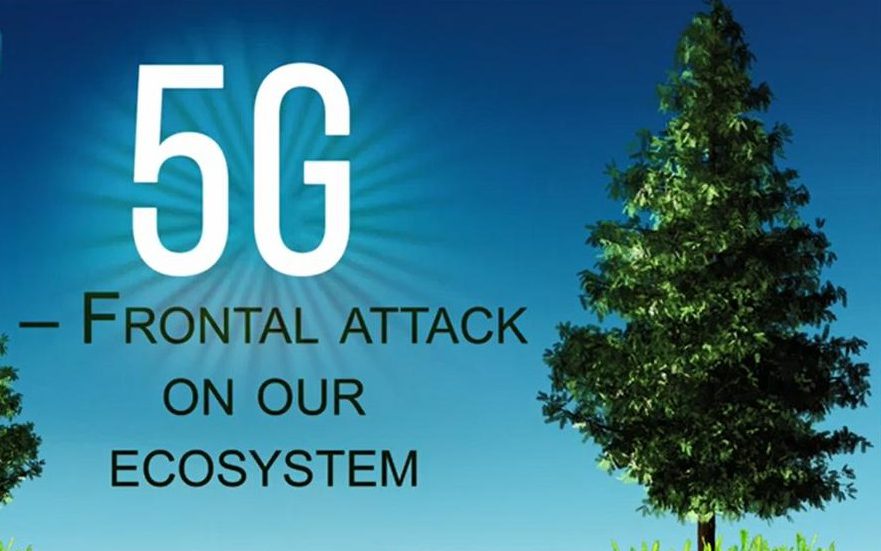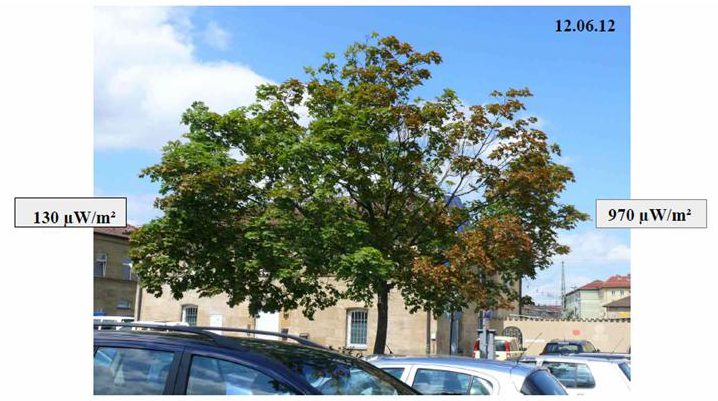The Green Dilemma of 5G densification
Author: Paul Ben-Ishai, PhD
As a physicist, my job involves a lot of reading. Mainly articles that turn on an obscure point in an obscure field that interests me, the author and maybe one other person – and he’s a physicist too. Occasionally, one comes across an article that should interest Joe Public, but it is written in such a way that Joe would doze off well before he got to the punch line! So on my desk landed an article with an impressive title, “Radiation Analysis in a Gradual 5G Network Deployment Strategy” [1]. And this is a doozy! Even better for me it is written by two Professors from the American University in Beirut, Lebanon, Ahmad El Hajj and Tarek Naous, researchers who could not normally cooperate with an Israeli. Geopolitics divides science too…..
 In this article they took a hard look at 5G Densification. “Densification” refers to the placement of many more antennas for 5G in the urban environment than we have today, in effect making the network of mobile base stations more dense.
In this article they took a hard look at 5G Densification. “Densification” refers to the placement of many more antennas for 5G in the urban environment than we have today, in effect making the network of mobile base stations more dense.
They took a typical neighbourhood in Austin Texas covered by the current 4G cellular network. Using a public database of cellphone towers (http://www.opencellid.org/) they plotted the positions of the existing tower infrastructure and decided to follow the supposed deployment of a new 5G network. First of all, using the published information of transmission strengths of the 4G antennas they estimated the average exposure felt in the streets of Austin (an excellent title for a Dolly Parton song!). Then they replaced the 4G with 5G on the existing towers, identified the blind spots in the map where there would be no coverage and added 5G antennas appropriately. Their conclusions were instructive.
- The area covered was 36 city blocks and the 4G network required 29 cellphone towers to cover it. The final 5G network required 100 antenna sites! This estimate only took into consideration coverage, not the supposed number of users. My feeling is that they underestimated the final number of antennas needed, but we will continue with their line of thought.
- The very generous exposure level of ambient electromagnetic radiation for the General Public is 10 W/m²according ICNIRP [2] and the FCC [3]. According to the Chinese Ministry of Health it is 0.1 W/m² [4] and for the Institute for Building Biology and Sustainability in Germany, a respected NGO in field of environmentally safe building and the urban environment, it should be 0.1 μW/m² (a million times less than the Chinese standard!).
The conclusion of the paper is that the densification of antennas will lead to a rise in exposure levels to an average of 0.6 W/m² at 5 meters from the antenna, too high for the Chinese standard and too high for a biologically safe standard, but ok for the FCC. Even worse, the chance of being exposed to levels as high as 2.5 W/m² rises significantly with the new 5G network, compared to the old 4G installation.

- The paper then asked what would occur if the transmission power of the antennas in this new 5G network was reduced to a level that the average exposure at a distance of 5 meters from any antenna matched the Chinese standard (which is the same standard for Russia, for parts of Italy and for Switzerland). The network would not work. They would need many more antennas.
So, what are the implications for us, an emerging nation in the 5G world. First of all, there are no realtime measurements of our exposure to ambient radiation in Israel, but there are some examples around the world. A problem with many of them is that the duty cycle of the measuring device used ‘misses’ most of the exposure because of the pulse like nature of cellphone transmissions.
Basically, if your cellphone sends and receives a series of a few thousand pulses (on/off) every second and your Field monitor only measures every second, then you are going to miss most of the signal. Fortunately, there are some works where the researcher took this into account and used an Electric field monitor capable of measuring this. Some of these measurements were done in China [5, 6], Switzerland ,Australia and Belgium[7, 8].
What these measurements show is that:
1. approximately 80% of the radiation we are exposed to comes from the mobile base stations and …
2. The ambient levels of radiation from base stations ranged from 0.0015 W/m² to 0.1 W/m².
That sounds great (it is less than the Chinese standard and much less than the ICNIRP standard), but don’t get too happy. At these levels we know that the ambient cellular radiation leads to heightened oxidative stress in the body [9]. And that eventually leads to ill health. However, I digress. What does this mean for 5G and Austin Texas?
It means at a minimum a 5G network will lead to a 6 fold increase in ambient radiation. But that is not all. Did you ask for a moment how much electricity such a network would need?
The average power consumption of the 3G base station with 3 active antennas is about 1.5 kW [10]. About the same as a coffee maker (although you won’t run a coffee maker 24 hours a day!). 4G sites typically need about 6 kW [11], or 2 electric heater fans, and 5G sites need 3 times that much at 18 kW!!! That is a lot of heater fans, or maybe an electric boiler.
So lets do a back-of-the-envelope calculation for our neighbourhood in Austin, Texas. We had 29 of 4G sites for complete coverage. That meant a power consumption of 29×6kW = 174kW!! That is a massive amount. But we need 100 sites for 5G and each station is 18 kW not 6 kW. That means our new 5G network is going to need 1800kW, or an increase of 1000%!!!
So, who is planning for this massive jump in power consumption? No one. Not in Austin, Texas and not in Jerusalem, Israel.

The 5G revolution, that the cellphone industry is so proud about, is likely to prove to be an ecological disaster that could easily wipe out the Carbon emissions savings of the Paris accord.
Maybe that is why the Chinese shut down their 5G network at night [12]. Did I forget to mention that the Chinese shut down their network to save power? How silly of me…
About the author: Paul Ben Ishai is an academic staff member of the Physics Department of Ariel University. He has authored 80 publications in various fields of physics and chemistry. He specializes in the interaction of human skin and high frequency radiowaves and is a scientific advisor for Environmental Health Trust.
About the article: this material was published on 3rd of April 2021 in The Times of Israel.
References (for those who want to know more)
[1] A. M. El-Hajj and T. Naous, “Radiation Analysis in a Gradual 5G Network Deployment Strategy,” in 2020 IEEE 3rd 5G World Forum (5GWF), Sep. 2020, pp. 448–453, doi: 10.1109/5GWF49715.2020.9221314.
[2] I. C. on N.-I. R. Protection (ICNIRP)1, “Principles for Non-Ionizing Radiation Protection,” Health Physics, vol. 118, no. 5, pp. 477–482, May 2020, doi: 10.1097/HP.0000000000001252.
[3] P. Ben Ishai, M. Ahonen, H. G. Silva, and D. Davis, Proposed FCC changes to Measuring and Evaluating Human Exposure to Radiofrequency Electromagnetic Fields and Wireless Power Transfer Devices are Flawed: need for biologically-based standards ( ET Docket No. 19–226; FCC 19–126; FRS 16618). 2020, p. 78.
[4] T. Wu, T. S. Rappaport, and C. M. Collins, “Safe for Generations to Come,” IEEE Microw Mag, vol. 16, no. 2, pp. 65–84, Mar. 2015, doi: 10.1109/MMM.2014.2377587.
[5] J. Liu, M. Wei, H. Li, X. Wang, X. Wang, and S. Shi, “Measurement and mapping of the electromagnetic radiation in the urban environment,” Electromagnetic Biology and Medicine, vol. 39, no. 1, pp. 38–43, Jan. 2020, doi: 10.1080/15368378.2019.1685540.
[6] C. Tang et al., “Analysis of the relationship between electromagnetic radiation characteristics and urban functions in highly populated urban areas,” Science of The Total Environment, vol. 654, pp. 535–540, Mar. 2019, doi: 10.1016/j.scitotenv.2018.11.143.
[7] M. Eeftens, S. Dongus, A. Bürgler, and M. Röösli, “A real-world quality assessment study in six ExpoM-RF measurement devices,” Environmental Research, vol. 182, p. 109049, Mar. 2020, doi: 10.1016/j.envres.2019.109049.
[8] C. R. Bhatt et al., “Assessment of personal exposure from radiofrequency-electromagnetic fields in Australia and Belgium using on-body calibrated exposimeters,” Environmental Research, vol. 151, pp. 547–563, Nov. 2016, doi: 10.1016/j.envres.2016.08.022.
[9] Zothansiama, M. Zosangzuali, M. Lalramdinpuii, and G. C. Jagetia, “Impact of radiofrequency radiation on DNA damage and antioxidants in peripheral blood lymphocytes of humans residing in the vicinity of mobile phone base stations,” Electromagn Biol Med, vol. 36, no. 3, pp. 295–305, 2017, doi: 10.1080/15368378.2017.1350584.
[10] O. Arnold, F. Richter, G. Fettweis, and O. Blume, “Power consumption modeling of different base station types in heterogeneous cellular networks,” in 2010 Future Network Mobile Summit, Jun. 2010, pp. 1–8.
[11] N. A. D. Jones and M. Editor 3/6/2019, “Power Consumption: 5G Basestations Are Hungry, Hungry Hippos,” Light Reading. https://www.lightreading.com/mobile/5g/power-consumption-5g-basestations-are-hungry-hungry-hippos/d/d-id/749979 (accessed Apr. 02, 2021).
[12] “Chinese 5G Not Living Up to Its Hype | Voice of America – English.” https://www.voanews.com/east-asia-pacific/voa-news-china/chinese-5g-not-living-its-hype (accessed Jan. 25, 2021).
yogaesoteric
September 18, 2021
